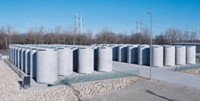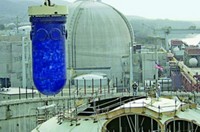Advertisement
Grab your lab coat. Let's get started
Welcome!
Welcome!
Create an account below to get 6 C&EN articles per month, receive newsletters and more - all free.
It seems this is your first time logging in online. Please enter the following information to continue.
As an ACS member you automatically get access to this site. All we need is few more details to create your reading experience.
Not you? Sign in with a different account.
Not you? Sign in with a different account.
ERROR 1
ERROR 1
ERROR 2
ERROR 2
ERROR 2
ERROR 2
ERROR 2
Password and Confirm password must match.
If you have an ACS member number, please enter it here so we can link this account to your membership. (optional)
ERROR 2
ACS values your privacy. By submitting your information, you are gaining access to C&EN and subscribing to our weekly newsletter. We use the information you provide to make your reading experience better, and we will never sell your data to third party members.
Environment
Decades For Decommissioning
As nuclear power plants age and more retire, cleanup and safety concerns grow
by Jeff Johnson
June 2, 2014
| A version of this story appeared in
Volume 92, Issue 22

Radioactive spent fuel remaining at a growing number of closed U.S. nuclear power plants could cause a severe accident. And state and local governments complain they have little authority to reduce, if not eliminate, this possible threat. What’s more, the radioactive waste is likely to remain at closed power plants for decades while plant owners carry out a complex process to clean up and decommission these shuttered sites.
An example of these sites, discussed at a May 14 Senate hearing, is the just-closed San Onofre Nuclear Generating Station in Southern California. Millions of people live within an hour’s drive of the plant. As with other nuclear power plants, the decommissioning of San Onofre’s three reactors is likely to take 60 years, according to the Nuclear Regulatory Commission (NRC).
More closures of U.S. nuclear power plants are probable in the coming decade as they reach their original design lifetimes of 40 years. With age, they face higher maintenance and operating costs as well as stiff competition from cheap natural gas and easily deployable renewable power sources. Sixty-two of the current 100 operating U.S. nuclear power plants are more than 30 years old, according to NRC.
In the U.S., 29 reactors are in various stages of decommissioning, according to NRC. Of these, 11 are considered completely decommissioned, said Michael F. Weber, NRC deputy executive director, at the Senate Environment & Public Works Committee hearing.
When a nuclear power plant’s operations cease, fuel is removed from the reactor, Weber said. Next, a plant’s owner has two years to submit to NRC a decommissioning plan and schedule for rendering the site safe for restricted and unrestricted use.
Decommissioning Bills Introduced
Sen. Barbara Boxer (D-Calif.) and committee members Sens. Bernard Sanders (I-Vt.) and Edward J. Markey (D-Mass.) have introduced three bills that would change the decommissioning process. One, S. 2324, would prohibit NRC from exempting a facility from emergency response or security requirements until all spent fuel has been moved from pools to dry casks. A second, S. 2326, would require power plant operators to formally consult with states and local communities located within 50 miles of a plant before submitting a decommissioning plan to NRC. A third bill, S. 2325, would require spent fuel to be moved from pools to dry cask storage within seven years from the time a decommissioning plan is submitted to NRC.
Committee Republican Sens. David Vitter of Louisiana and Jeff B. Sessions of Alabama oppose the three bills and warned of significant problems for the nuclear energy industry from too much regulation.
Another member, Sen. James Inhofe (R-Okla.), complimented NRC for its voluntary efforts to involve states and the public in decommissioning decisions, adding that new regulations were unnecessary.
However, during decommissioning—and even at most of the 11 reactors considered decommissioned—spent fuel remains on-site, Weber said. Spent fuel has been removed from the sites of only nine of the 29 reactors going through decommissioning. Those nine are the oldest and smallest of decommissioned facilities, NRC data indicate.
In part, what’s holding up the decommissioning process is the lack of a storage place for large quantities of spent fuel and other radioactive waste because the U.S. has failed to construct a permanent high-level radioactive waste repository. So spent fuel remains at the nuclear power plant where it was created, resting in steel-lined, water-filled, swimming-pool-like structures or entombed in concrete and steel dry casks.
Most of the spent-fuel assemblies, about 70%, are crammed into pools that hold several times more assemblies than originally planned, Sen. Barbara Boxer (D-Calif.), the committee’s chair, stressed at the hearing.
“At San Onofre, the nuclear fuel pools were designed to hold 1,600 spent-fuel assemblies,” she said. “But currently, they hold more than 2,600. Overcrowding puts them at risk of serious safety consequences if they experience an accident or terrorist attack.” Some 8 million people live within a 50-mile radius of the San Onofre power plant, Boxer added.
NRC’s stance is that the fuel is safe where it is, in either pools or dry casks. In recent years, particularly after Japan’s Fukushima Daiichi nuclear accident in 2011, many U.S. power plant owners have shifted spent fuel from pools to safer dry casks. About 30% of assemblies have made this switch. Regardless, spent fuel remains at the power plant sites, near population centers.
Boxer contrasted NRC’s views about spent fuel storage with a 2003 research paper coauthored by NRC Chair Allison M. Macfarlane, before she became a commissioner. That paper warned against continued on-site storage, saying radioactive contamination from a spent-fuel fire “could be significantly worse” than that from the Chernobyl disaster.
Meanwhile, communities and state officials said NRC pays little attention to their concerns about decommissioning. Donald Mosier, a city council member of the small community of Del Mar, Calif., a few miles south of the San Onofre power station, told the committee he is pleased that the plant is closed. Mosier said he wants the fuel removed quickly.
But decommissioning schedules are left to NRC and the plant owner, he said. Local input is at best “token.”
“The concept that all of the challenges facing safe decommissioning take place in the absence of any meaningful federal, state, or local regulation is mind-boggling,” Mosier said.
Christopher Recchia, commissioner of the Vermont Public Service Department, agreed with Mosier. Last year, the owners of the state’s only nuclear power plant, Vermont Yankee, announced that the power plant would close in late 2014, he told the committee. The state applauded the announcement as it had long opposed the facility and had adopted an energy plan with the goal of obtaining 90% of its electricity from renewable sources. Vermont, Recchia added, had not purchased power from the nuclear plant since March 2012.
Consequently, the state wants the plant decommissioned soon, he said. Like Mosier, Recchia complained that he had no way to influence the schedule for decommissioning. NRC, he said, is “under no obligation to respond to state concerns or comments.”
The plant owner has near-total control, Recchia said, “Indeed, NRC, itself, is under no obligation to take formal action on the owner’s plan.
“I know of no other regulatory agency, from a local zoning board to state or federal agencies, that claims it is not required to make an affirmative decision on a plan of this magnitude, complete with reasoning explained and a responsive summary addressing comments received.”
In response, Weber stressed that NRC faithfully considers state and local views, although it is not required to do so.
Boxer is also vexed about NRC’s willingness to suspend many safety and emergency response requirements during the lengthy decommission period. She and several other senators have introduced legislation to limit NRC’s ability to suspend these requirements until the facility owner has moved all spent fuel to dry casks. The bills would also require NRC to consult with state and local officials during the decommissioning process. The legislation is likely to have a difficult path because NRC has many supporters in Congress.




Join the conversation
Contact the reporter
Submit a Letter to the Editor for publication
Engage with us on Twitter